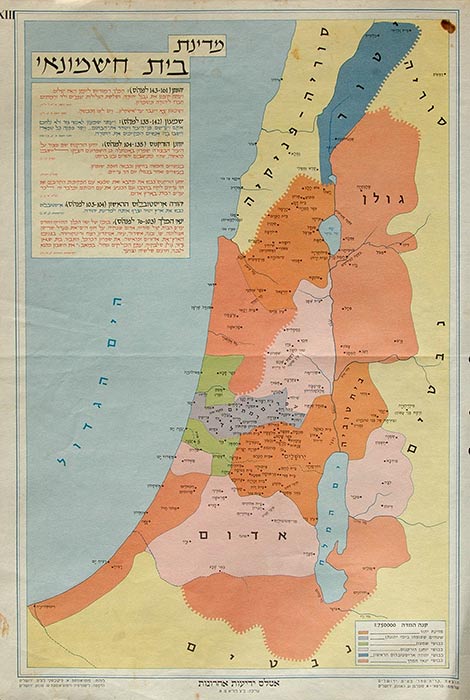Shop
Vintage Israeli Poster Map “The Hasmonean Kingdom” Biblical Map
$550.00
1 in stock
| Dimensions | 32 × 49 cm |
|---|---|
| Artist / Creator | |
| Technique | |
| Year | 1950 |
| Condition | |
| Size | 49×32 cm ~ 19×13 inch |
| A |
Description
andlt;pandgt;The Hasmonean dynasty[ (/ˌhandamp;aelig;zməˈniːən/; Hebrew: חשמונאיםandamp;lrm;andamp;lrm;, Roman. Ḥashmona’im) was the ruling dynasty of Judea and surrounding regions during classical antiquity. Between c.andamp;thinsp;140 and c.andamp;thinsp;116 BCE the dynasty ruled semi-autonomously from the Seleucids in the region of Judea. From 110 BCE, with the Seleucid empire disintegrating, the dynasty became fully independent, expanded into the neighbouring regions of Samaria, Galilee, Iturea, Perea, and Idumea, and took the title “basileus”. Some modern scholars refer to this period as an independent kingdom of Israel.[3] In 63 BCE, the kingdom was conquered by the Roman Republic, broken up and set up as a Roman client state. The dynasty had survived for 103 years before yielding to the Herodian dynasty in 37 BCE. Even then, Herod the Great tried to bolster the legitimacy of his reign by marrying a Hasmonean princess, Mariamne, and planning to drown the last male Hasmonean heir at his Jericho palace. The dynasty was established under the leadership of Simon Maccabaeus, two decades after his brother Judas the Maccabee ( יהודה המכבי “Y’hudhah HaMakabi”) defeated the Seleucid army during the Maccabean Revolt. According to historical sources, including 1 Maccabees and 2 Maccabees and the first book of The Jewish War by Jewish historian Flavius Josephus (AD 37andamp;ndash;c.andamp;thinsp;100),[4] after Antiochus IV’s successful invasion of Ptolemaic Egypt was turned back by the intervention of the Roman Republic,[5][6] Antiochus instead moved to assert strict control over the Seleucid satrapy of Coele Syria and Phoenicia,[7] sacking Jerusalem and its Temple, suppressing Jewish and Samaritan religious and cultural observances,[7] and imposing Hellenistic practices. The ensuing revolt by the Jews (167 BCE) began a twenty-five-year period of Jewish independence potentiated by the steady collapse of the Seleucid Empire under attacks from the rising powers of the Roman Republic and the Parthian Empire. However, the same power vacuum that enabled the Jewish state to be recognized by the Roman Senate c.andamp;thinsp;139 BCE was later exploited by the Romans themselves. Hyrcanus II and Aristobulus II, Simon’s great-grandsons, became pawns in a proxy war between Julius Caesar and Pompey the Great. The deaths of Pompey (48 BCE), Caesar (44 BCE), and the related Roman civil wars temporarily relaxed Rome’s grip on Israel, allowing a very brief Hasmonean resurgence backed by the Parthian Empire. This short independence was rapidly crushed by the Romans under Mark Antony and Octavian. The installation of Herod the Great (an Idumean) as king in 37 BCE made Israel a Roman client state and marked the end of the Hasmonean dynasty. In AD 6, Rome joined Judea proper, Samaria and Idumea (biblical Edom) into the Roman province of Iudaea. In AD 44, Rome installed the rule of a Roman procurator side by side with the rule of the Herodian kings (specifically Agrippa I 41andamp;ndash;44 and Agrippa II 50andamp;ndash;100).andlt;/pandgt;


 Original Group Photo of Maccabi Tel Aviv Wrestling club, 1930
Original Group Photo of Maccabi Tel Aviv Wrestling club, 1930




